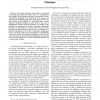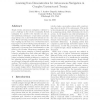682 search results - page 11 / 137 » Autonomous Environment and Task Adaptation for Robotic Agent... |
ICRA
2010
IEEE
13 years 6 months ago
2010
IEEE
— This paper addresses the problem of acquiring a hierarchically structured robotic skill in a nonstationary environment. This is achieved through a combination of learning primi...
ICRA
2010
IEEE
13 years 5 months ago
2010
IEEE
To build autonomous robots capable to plan and control tasks in human environments, we need a description of trajectories that allows the robot to reason on his moves. In this pape...
FLAIRS
2006
13 years 9 months ago
2006
This paper considers a robot with multiple sensors navigating an unknown, heterogeneous environment. In these cases sensor errors may produce an unsuitable model of the world. For...
IJRR
2010
13 years 6 months ago
2010
Rough terrain autonomous navigation continues to pose a challenge to the robotics community. Robust navigation by a mobile robot depends not only on the individual performance of ...
ECAL
2005
Springer
14 years 1 months ago
2005
Springer
This paper is about the design of an artificial neural network to control an autonomous robot that is required to iteratively solve a discrimination task based on time-dependent s...


